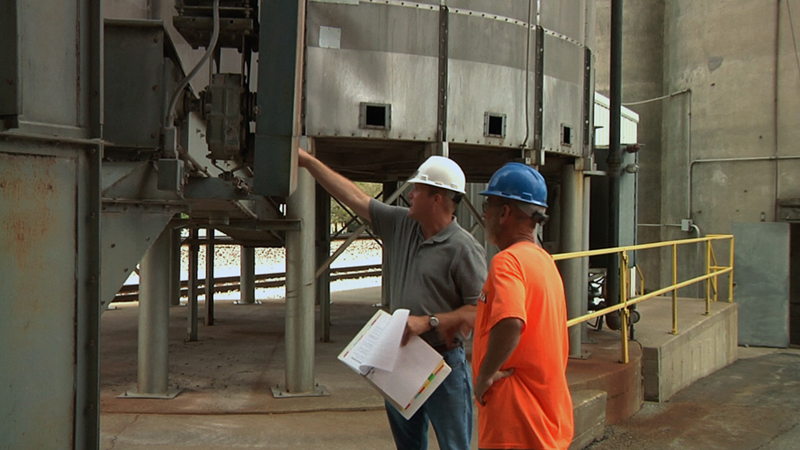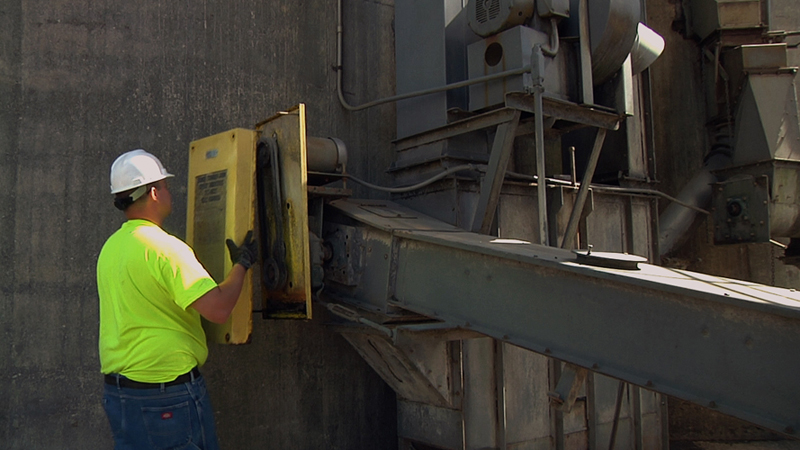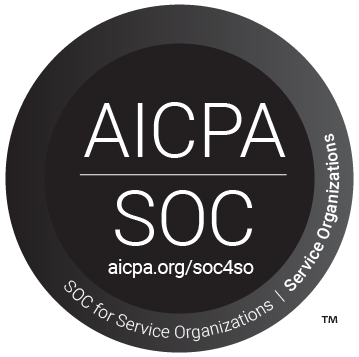Grain Handling Facilities
REGULATORY CITATION
OSHA - 29 CFR 1910.272 - Grain handling facilities
Origin Date 12-31-1987
WHAT IS IT?
Standard protects employees by controlling grain dust fires and explosions at grain handling facilities.
WHO DOES IT APPLY TO?
Employers that store or handle grain.
HOW CAN WE HELP?
CLICK HERE to learn how Asmark can help you.
INTRODUCTION
Devastating fires and explosions have occurred in grain handling facilities. These fires and explosions can most often be attributed to the presence of combustible grain dust (fuel), the availability of an ignition source, air, and in the case of an explosion, confinement. Employers must have a planned approach for controlling and minimizing dust in grain handling facilities.
TRAINING

Employers of grain handling facilities must provide training to employees at least annually and when changes in job assignment will expose them to new hazards. Current employees, and new employees prior to starting work, must be trained in at least the following:
- General safety precautions associated with the facility, including recognition and preventive measures for the hazards related to dust accumulations and common ignition sources such as smoking; and,
- Specific procedures and safety practices applicable to their job tasks, including but not limited to, cleaning procedures for grinding equipment, clearing procedures for choked legs, housekeeping, hot work, preventive maintenance and lockout/tagout procedures.
Employees assigned special tasks, such as bin entry and handling of flammable or toxic substances, must be provided training to perform these tasks safely. Training for an employee who enters grain storage structures includes training about engulfment and mechanical hazards and how to avoid them.
Housekeeping
Employers of grain handling facilities must develop and implement a written housekeeping program that establishes the frequency and methods determined best to reduce accumulations of fugitive grain dust on ledges, floors, equipment and other exposed surfaces. In addition, the housekeeping program for grain elevators must address fugitive grain dust accumulations at priority housekeeping areas.
Priority housekeeping areas must include at least the following:
- Floor areas within 35 feet of inside bucket elevators;
- Floors of enclosed areas containing grinding equipment; and
- Floors of enclosed areas containing grain dryers located inside the facility.
The employer must immediately remove any fugitive grain dust accumulations whenever they exceed 1/8 inch in priority housekeeping areas, pursuant to the housekeeping program, or must demonstrate and assure, through the development and implementation of the housekeeping program, that equivalent protection is provided.
The use of compressed air to blow dust from ledges, walls and other areas must only be permitted when all machinery that presents an ignition source in the area is shut-down and all other known potential ignition sources in the area are removed or controlled. Grain and product spills must not be considered fugitive grain dust accumulations. However, the housekeeping program must address the procedures for removing such spills from the work area.
PREVENTATIVE MAINTENANCE AND INSPECTIONS

The Occupational Safety and Health Administration (OSHA) does not mandate a written preventive maintenance program. However, all electrical and mechanical equipment must be kept in good operating condition. The employer must implement preventive maintenance procedures consisting of:
- Regularly scheduled inspections of the mechanical and safety control equipment associated with dryers, grain stream processing equipment, dust collection equipment, including filter collectors and bucket elevators; and
- Lubrication and other appropriate maintenance in accordance with manufacturers' recommendations or as determined necessary by prior operating records.
The employer must promptly correct dust collection systems which are malfunctioning or operating below designed efficiency. Additionally, the employer must promptly correct, or remove from service, overheated bearings and slipping or misaligned belts associated with inside bucket elevators.
A certification record must be maintained for each inspection. It must contain the date of the inspection, the name of the person who performed the inspection and the serial number, or other identifier, of the equipment that was inspected. The employer must implement procedures for the use of tags and locks which will prevent the inadvertent application of energy or motion to equipment being repaired, serviced or adjusted, which could result in employee injury. Such locks and tags must be removed only by the employee installing them or, if unavailable, by his or her supervisor, in accordance with established procedures.
ENGULFMENT HAZARDS

Whenever an employee enters a grain storage structure from a level at or above the level of the stored grain or grain products, or whenever an employee walks or stands on or in stored grain of a depth which poses an engulfment hazard, the employer must equip the employee with a body harness with lifeline or a boatswain's chair that meets the requirements of subpart D of part 272. The lifeline must be so positioned, and of sufficient length, to prevent the employee from sinking further than waist-deep in the grain.
Exception: Where the employer can demonstrate that the protection is not feasible or creates a greater hazard, the employer must provide an alternative means of protection which is demonstrated to prevent the employee from sinking further than waist-deep in the grain.
Note: When the employee is standing or walking on a surface which the employer demonstrates is free from engulfment hazards, the lifeline or alternative means may be disconnected or removed.
An observer, equipped to provide assistance, must be stationed outside the bin, silo or tank being entered by an employee and maintain communications (visual, voice or signal line) with the employee. The employer must provide equipment for rescue operations which is specifically suited for the bin, silo or tank being entered. The employee acting as observer must be trained in rescue procedures, including notification methods for obtaining additional assistance. No employee can be permitted either underneath a bridging condition or in any other location where an accumulation of grain on the sides or elsewhere could fall and engulf that employee.
HOT WORK
The employer must issue a permit for all hot work except:
- Where the employer or the employer's representative (who would otherwise authorize the permit) is present while the hot work is being performed;
- In welding shops authorized by the employer; and
- In hot work areas authorized by the employer which are located outside of the grain handling structure.
The permit must certify that the requirements were implemented prior to beginning the hot work operations. The permit must be kept on file until completion of the hot work operations.
Choked leg - a condition of material buildup in the bucket elevator that results in the stoppage of material flow and bucket movement. A bucket elevator is not considered choked that has the up-leg partially or fully loaded and has the boot and discharge cleared allowing bucket movement.
Grain elevator - a facility engaged in the receipt, handling, storage and shipment of bulk raw agricultural commodities such as corn, wheat, oats, barley, sunflower seeds and soybeans.
Hot work - work involving electric or gas welding, cutting, brazing or similar flame producing operations.
Permit - a written certification by the employer, authorizing employees to perform identified work operations subject to specified precautions.
FAQs AND INTERPRETATIONS
OSHA GRAIN HANDLING
PUBLICATION
OSHA STANDARD
INTERPRETATIONS
HOW CAN WE HELP?
LEARN MORE ABOUT WHAT
ASMARK CAN DO FOR YOU

